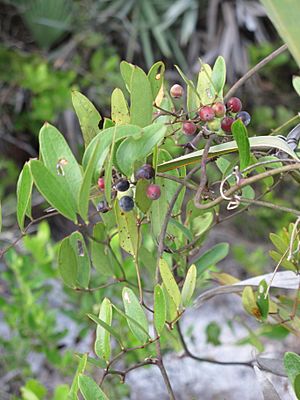Laurel greenbrier facts for kids
Quick facts for kids Laurel greenbrier |
|
|---|---|
 |
|
| Conservation status | |
| Scientific classification | |
| Genus: |
Smilax
|
| Species: |
laurifolia
|
| Synonyms | |
|
|
Smilax laurifolia is a cool flowering plant from the greenbrier family. People call it by many names like laurel greenbrier, laurelleaf greenbrier, bamboo vine, and even blaspheme vine. This plant grows naturally in the southeastern United States. You can find it along the Gulf and Atlantic coastal plains, stretching from Texas all the way to New Jersey. It also grows inland in states like Arkansas, Oklahoma, and Tennessee. You can even spot it in Cuba and the Bahamas!
Contents
What is Laurel Greenbrier?
This plant is a type of monocot. This means it's a plant that starts with just one seed leaf. It's a woody vine that grows very thick. It often climbs over other plants, forming dense patches.
Stems and Leaves
The stems of the laurel greenbrier can grow very long. They can reach five meters (about 16 feet) or even more! These stems have sharp prickles. Some of these prickles can be over a centimeter long. The plant grows from a huge, woody underground stem called a rhizome. New shoots can grow super fast, up to 7 centimeters (almost 3 inches) every day!
The leaves are tough and stay green all year. They can be long and narrow, spear-shaped, or oval. They grow up to 13 centimeters (about 5 inches) long and 6 centimeters (about 2.4 inches) wide. The leaf stems, called petioles, twist. This makes the leaves stand up straight.
Flowers and Berries
The flowers grow in clusters called umbels. Each cluster can have up to 25 flowers. They grow where the leaves meet the stem. Each flower has whitish or yellowish petals, called tepals. Each tepal is about half a centimeter long.
After the flowers, the plant grows shiny, waxy black berries. These berries are small, about 5 to 8 millimeters long. What's interesting is that the berries don't ripen right away. They take two growing seasons to fully mature after they first appear!
Where Does it Grow?
This plant loves wet places. You can find it in bogs, swamps, and marshy areas. The soil where it grows is usually very wet, and the areas are often flooded. It's a very common plant in the Everglades. It's also a key plant in the Okefenokee Swamp.
Plant Neighbors
Laurel greenbrier often grows under taller trees. These trees include cypress, swamp blackgum, and white bay. Other trees it grows with are loblolly bay, sweet bay, and red maple. You might also see it under cassena, titi, and southern white cedar.
In the lower plant layers, it grows with other shrubs. These include hurrahbush, leucothoe, and sweetspire. It also grows near poor-man's soap, coral greenbrier, and honeycup.
How it Affects its Environment
This plant can grow very quickly. It sometimes competes with young tree seedlings. For example, it can make it harder for southern white cedar seedlings to grow. In sunny spots, it grows even better. It can form very thick patches there.
If the plant is burned or damaged, it grows back strongly. This is because of its large underground rhizome. This fast-growing vine can sometimes be a problem for people trying to grow trees.
Animals and Rare Plants
Laurel greenbrier provides a home and food for many animals. Animals like white-tailed deer, bobcat, and gray squirrel use it. Reptiles like the Eastern diamondback rattlesnake and American alligator also live near it. Even amphibians like the pine barrens tree frog use this plant. It's also important for the endangered red-cockaded woodpecker.
This plant also grows near some rare plants. These include white wickey, arrowleaf shieldwort, and spring-flowering goldenrod. Another rare plant found with it is rough-leaf loostrife.
Traditional Uses
Long ago, Native American groups used this plant. They used it for medicine. For example, the Cherokee people used it to treat sores and burns.
The large underground rhizome was also a source of food. The Choctaw people would make it into fried cakes and bread.
See also
 In Spanish: Smilax laurifolia para niños
In Spanish: Smilax laurifolia para niños


